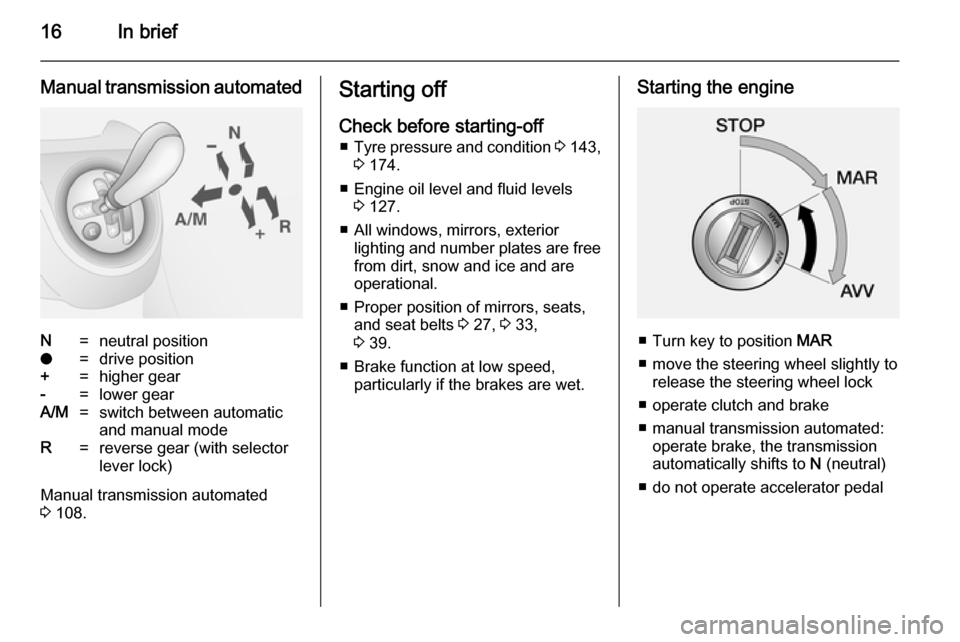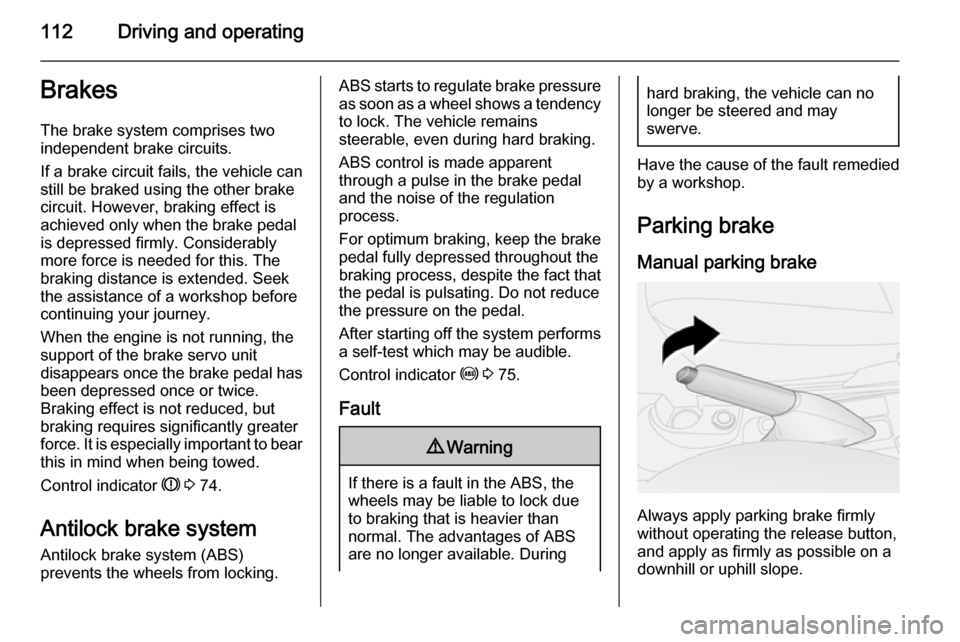brakes VAUXHALL COMBO 2014 Owner's Manual
[x] Cancel search | Manufacturer: VAUXHALL, Model Year: 2014, Model line: COMBO, Model: VAUXHALL COMBO 2014Pages: 187, PDF Size: 4.15 MB
Page 18 of 187

16In brief
Manual transmission automatedN=neutral positiono=drive position+=higher gear-=lower gearA/M=switch between automatic
and manual modeR=reverse gear (with selector
lever lock)
Manual transmission automated
3 108.
Starting off
Check before starting-off ■ Tyre pressure and condition 3 143,
3 174.
■ Engine oil level and fluid levels 3 127.
■ All windows, mirrors, exterior lighting and number plates are free
from dirt, snow and ice and are
operational.
■ Proper position of mirrors, seats, and seat belts 3 27, 3 33,
3 39.
■ Brake function at low speed, particularly if the brakes are wet.Starting the engine
■ Turn key to position MAR
■ move the steering wheel slightly to release the steering wheel lock
■ operate clutch and brake
■ manual transmission automated: operate brake, the transmission
automatically shifts to N (neutral)
■ do not operate accelerator pedal
Page 103 of 187

Driving and operating101Driving and operatingDriving hints............................... 101
Starting and operating ...............101
Engine exhaust .......................... 106
Manual transmission ..................107
Manual transmission automa‐
ted .............................................. 108
Brakes ........................................ 112
Ride control systems .................113
Cruise control ............................. 115
Object detection systems ........... 116
Fuel ............................................ 118
Towing ....................................... 123Driving hints
Control of the vehicleNever coast with engine not
running (except during Autostop)
Many systems will not function in this
situation ( e.g. brake servo unit, power
steering). Driving in this manner is a
danger to yourself and others. All
systems function during an Autostop,
but there will be a controlled reduction
in power steering assist and vehicle
speed is reduced.
Stop-start system 3 103.
Pedals
To ensure the pedal travel is
uninhibited, there must be no mats in the area of the pedals.Starting and operating
New vehicle running-in Do not brake unnecessarily hard for
the first few journeys.
During the first drive, smoke may
occur because of wax and oil
evaporating off the exhaust system. Park the vehicle in the open for a
while after the first drive and avoid
inhaling the fumes.
During the running-in period fuel and engine oil consumption may be
higher and the cleaning process of the diesel particle filter may take
place more often. Autostop may be inhibited to allow for charging the
battery.
Diesel particle filter 3 106.
Page 114 of 187

112Driving and operatingBrakes
The brake system comprises two
independent brake circuits.
If a brake circuit fails, the vehicle can
still be braked using the other brake
circuit. However, braking effect is
achieved only when the brake pedal
is depressed firmly. Considerably
more force is needed for this. The
braking distance is extended. Seek the assistance of a workshop before
continuing your journey.
When the engine is not running, the
support of the brake servo unit
disappears once the brake pedal has been depressed once or twice.
Braking effect is not reduced, but
braking requires significantly greater
force. It is especially important to bear this in mind when being towed.
Control indicator R 3 74.
Antilock brake system Antilock brake system (ABS)
prevents the wheels from locking.ABS starts to regulate brake pressure as soon as a wheel shows a tendency
to lock. The vehicle remains
steerable, even during hard braking.
ABS control is made apparent
through a pulse in the brake pedal
and the noise of the regulation
process.
For optimum braking, keep the brake
pedal fully depressed throughout the
braking process, despite the fact that
the pedal is pulsating. Do not reduce
the pressure on the pedal.
After starting off the system performs a self-test which may be audible.
Control indicator u 3 75.
Fault9 Warning
If there is a fault in the ABS, the
wheels may be liable to lock due
to braking that is heavier than
normal. The advantages of ABS are no longer available. During
hard braking, the vehicle can nolonger be steered and may
swerve.
Have the cause of the fault remedied
by a workshop.
Parking brake Manual parking brake
Always apply parking brake firmly
without operating the release button,
and apply as firmly as possible on a
downhill or uphill slope.
Page 115 of 187

Driving and operating113
To release the parking brake, pull thelever up slightly, press the release
button and fully lower the lever.
To reduce the operating forces of the
parking brake, depress the foot brake
at the same time.
A warning chime will sound if a certain speed is exceeded with the parking
brake applied.
Notice
The volume of the warning chime
can also be adjusted via the Driver
Information Centre 3 79.
Control indicator R 3 74.
Brake assist
If the brake pedal is depressed
quickly and forcefully, maximum
brake force is automatically applied
(full braking).
Maintain steady pressure on the
brake pedal for as long as full braking is required. Maximum brake force is
automatically reduced when the
brake pedal is released.Hill start assist
The system helps prevent unintendedmovement when driving away on
inclines.
When releasing the foot brake after
stopping on an incline, the brakes
remain on for a further two seconds.
The brakes release automatically as
soon as the vehicle begins to
accelerate.
If control indicator Z illuminates
while driving, there is a fault in the Hill
start assist 3 75 . Seek the assistance
of a workshop to have the fault
remedied.
The Hill start assist is not active
during an Autostop.
Stop-start system 3 103.Ride control systems
Traction Control system
The Anti-Slip Regulator (ASR) is a
component of the Electronic Stability
Program (ESP).
ASR improves driving stability when
necessary, regardless of the type of
road surface or tyre grip, by
preventing the drive wheels from
spinning.
As soon as the drive wheels starts to spin, engine output is reduced and
the wheel spinning the most is braked
individually. This considerably
improves the driving stability of the
vehicle on slippery road surfaces.
ASR is operational as soon as the
control indicator x extinguishes.
When ASR is active, control indicator x flashes.
Page 132 of 187

130Vehicle careBrakesA squealing noise, or illumination ofbrake pad wear control indicator F
indicates that the brake lining is at its
minimum thickness.
Continued driving is possible but
have the brake linings replaced as
soon as possible.
Once new brake linings are installed,
do not brake unnecessarily hard for
the first few journeys.
Brake pad wear indicator F 3 75.
Brake fluid9 Warning
Brake fluid is poisonous and
corrosive. Avoid contact with eyes, skin, fabrics and painted surfaces.
The brake fluid level must be betweenthe MIN and MAX marks.
When topping up, ensure maximum cleanliness as contamination of the
brake fluid can lead to brake system
malfunctions. Have the cause of the
loss of brake fluid remedied by a
workshop.
Only use high-performance brake
fluid approved for the vehicle.
Brake and clutch fluid 3 159.
Battery
The vehicle battery is maintenance-
free provided that the driving profile
allows sufficient charging of the
battery. Short-distance-driving and
frequent engine starts can discharge
the battery. Avoid the use of
unnecessary electrical consumers.
Batteries do not belong in household
waste. They must be disposed of at
an appropriate recycling collection
point.
Laying up the vehicle for more than
4 weeks can lead to battery
discharge. Disconnect the clamp from the negative terminal of the vehicle
battery.
Ensure the ignition is switched off
before connecting or disconnecting
the vehicle battery.
Page 182 of 187

180IndexAAccessories and vehicle modifications .......................... 125
Adjustable air vents .....................99
Airbag activation ........................... 79
Airbag and belt tensioners ...........73
Airbag deactivation ..........45, 74, 79
Airbag system .............................. 41
Air conditioning regular operation ................................ 100
Air conditioning system ................ 96
Air intake .................................... 100
Air vents........................................ 99
Alert .............................................. 85
Antilock brake system ................ 112
Antilock brake system (ABS) .......75
Anti-Slip Regulator (ASR) ...........113
Anti-theft locking system .............. 26
Appearance care ........................155
Armrest ......................................... 35
Ashtrays ....................................... 67
ASR (Anti-Slip Regulator) ...........113
Audible warning chimes................ 85
Autoclose ...................................... 79
Automatic fuel cut-off ............85, 103
Automatic locking .........................79B
Battery ....................................... 130
Battery discharge protection ........94
Belts.............................................. 38 Bonnet ....................................... 127
Brake and clutch fluid .................159
Brake assist ............................... 113
Brake fluid .................................. 130
Brake pad wear ............................ 75
Brakes ............................... 112, 130
Brake system ............................... 74
Breakdown.................................. 153
Bulb replacement ....................... 132
C Capacities .................................. 173
Car Pass ...................................... 19
Catalytic converter .....................107
Central locking system ................21
Centre high-mounted brake light 135
Change engine oil .......................77
Changing tyre and wheel size ...144
Charging system .......................... 74
Child locks ................................... 22
Child restraint installation locations ................................... 49
Child restraints.............................. 47
Child restraint systems ................47